Everybody knows that all German Shepherd dogs are black and tan, right?
Wrong! Okay, some of you probably knew this, but these amazing dogs come in ten other colors aside from black and tan, including white!
Even so, check out the American Kennel Club’s breed standards, and you’ll discover that White German Shepherds are disqualified from AKC dog shows, even though this is listed as a standard color. For some reason, White German Shepherds are ‘undesirable.’
Controversy over this has raged for many years, so what’s it all about?
We’re going to discover the reasons for all the fuss and provide you with all the information you could possibly need about the wonderful White GSD.
What’s The Difference Between A White German Shepherd And A German Shepherd?

Aside from their coat color, they are pretty much the same. However, they may differ in temperament and body shape, and we’ll look into this later.
They both have the distinctive wolf-like features:
• Erect ears.
• A long, pointed muzzle.
• A bushy tail.
• A large, solid body that slopes toward the back end.
The only reason why these dogs are considered ‘undesirable’ and disqualified from shows is that myths persist about their alleged inferiority.
Some die-hard standard German Shepherd enthusiasts refuse to accept that the white version is acceptable because they believe it is defective.
The roots of this erroneous belief stretch back to Nazi Germany, where it was suggested by certain parties (Hitler included) that the White GSD risked ‘polluting the breed.’
Surely if we’ve learned anything from history, it’s that we should reject anything Nazis believed, especially when it comes to genetics?
Even so, the myths still abound. Here are some of the reasons some people give for opposing the White GSD:
Why Are White German Shepherds Undesirable?
Some people believe that the AKC is not keen on the White GSD because they are sheepdogs, and a white sheepdog is no good as it can’t be seen among the flock because its white coat blends in.
However, the facts show that the opposite is true. White herding dogs of all breeds were highly prized in times past because they could hide among the flock. Aside from giving predators a nasty surprise, it allowed the shepherd to spot wolves easily.
So, this ridiculous notion is pretty easy to debunk.
Besides, most of these dogs will never see a sheep in their lifetime, as they are family pets, not working dogs.
White German Shepherds Puppies Cause ‘Fading’
Another false claim!
In the past, many people believed that if you bred a white dog with a standard color, it would cause faded colors in the pups. People were worried that the German Shepherd dog breed would eventually look very different because of this.
As a result, thousands of white pups were needlessly slaughtered, mainly in Germany from the 1930s onwards.
Recent research has proved that white dogs do not affect the coat color of subsequent pups. If you breed two whites together, they’ll produce solid white puppies. However, a white dog and a non-white dog have a 50:50 chance of making a white pup only if the non-white dog carries the recessive gene that causes the white coat.
Otherwise, all the pups will be different colors, and none of them will have diluted colors.
White GSDs Have More Behavioral Problems
This is another reason given by those who dislike these beautiful white dogs. Though it has to be said, there is no evidence to support this claim.
Some people claim that the White German Shepherd dog is highly-strung and timid, making it nervous and excitable. They say that it needs more socializing as a puppy to help it calm down and accept the presence of strangers and other dogs.
This is somehow linked to a deficiency of character, something in their genes that makes them inferior to other German Shepherds.
White German Shepherd Temperament: The Best Dog For Families?
Rather than being inferior, many White GSD owners suggest that the opposite is true, that these dogs are calmer and more affectionate than ‘normal’ GSDs, and they make great family pets!
All the evidence supports this second view, as many White German Shepherd breeders have deliberately bred dogs with a more mellow and sweeter temperament.
These fantastic creatures are great with families, but those with a softer temperament are not so good as guard dogs, service dogs, or for taking part in doggy protection sports. Even so, they excel at agility courses and generally having fun.
In the end, any opposition to this is all about keeping purebred dogs as close to the breeding standards as possible. German Shepherds are working dogs, and many people don’t like the idea of a ‘softer’ German Shepherd!
Do White Shepherd Dogs Have Health Problems?
The white version of the GSD has no more problems than the standard version. In fact, if anything, it’s clear that the reverse is true! (see further down for details on common health problems)
Some people persist in believing that all solid or predominantly white dogs are prone to deafness. This is incorrect: canine deafness is often caused by the merle or piebald genes, and White German Shepherds don’t carry either!
Another mistake people make is to link the white color with albinism, and we’ll explore this in the next section.
Are White German Shepherds Albino?
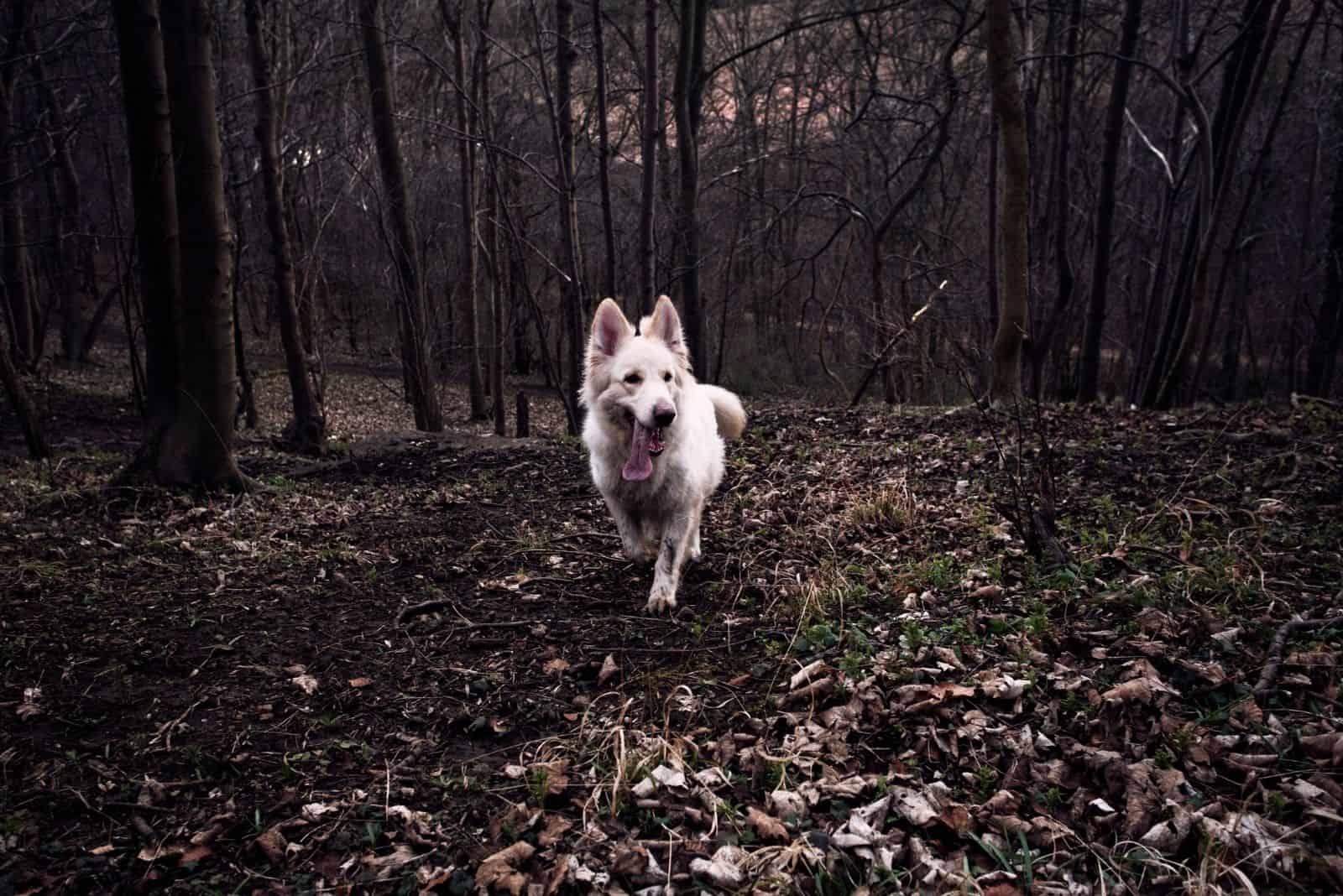
No, White German Shepherd dogs are not albino dogs!
This is a common mistake made by thousands of people. While all albino dogs are white, not all white dogs are albino.
It’s impossible to identify albinism in dogs without performing genetic tests. However, most will have a pink nose and pink eyes with pink rims. They also often suffer from a host of health issues.
Albinism is a genetic mutation that causes dogs to be complete or partial albino because of an absence of the pigment melanin in the skin, eyes, and fur.
This makes the dogs sensitive to sunlight and prone to sunburn and skin cancer.
Also, the lack of pigment in the ear canal can cause the nerve endings to break down, resulting in deafness.
A lack of melanin also affects their eyes: albinos are often born with abnormally small eyes or deformities resulting in blindness. They can be blind from birth or have significant problems with their eyesight.
Where Did The White Coat Come From?
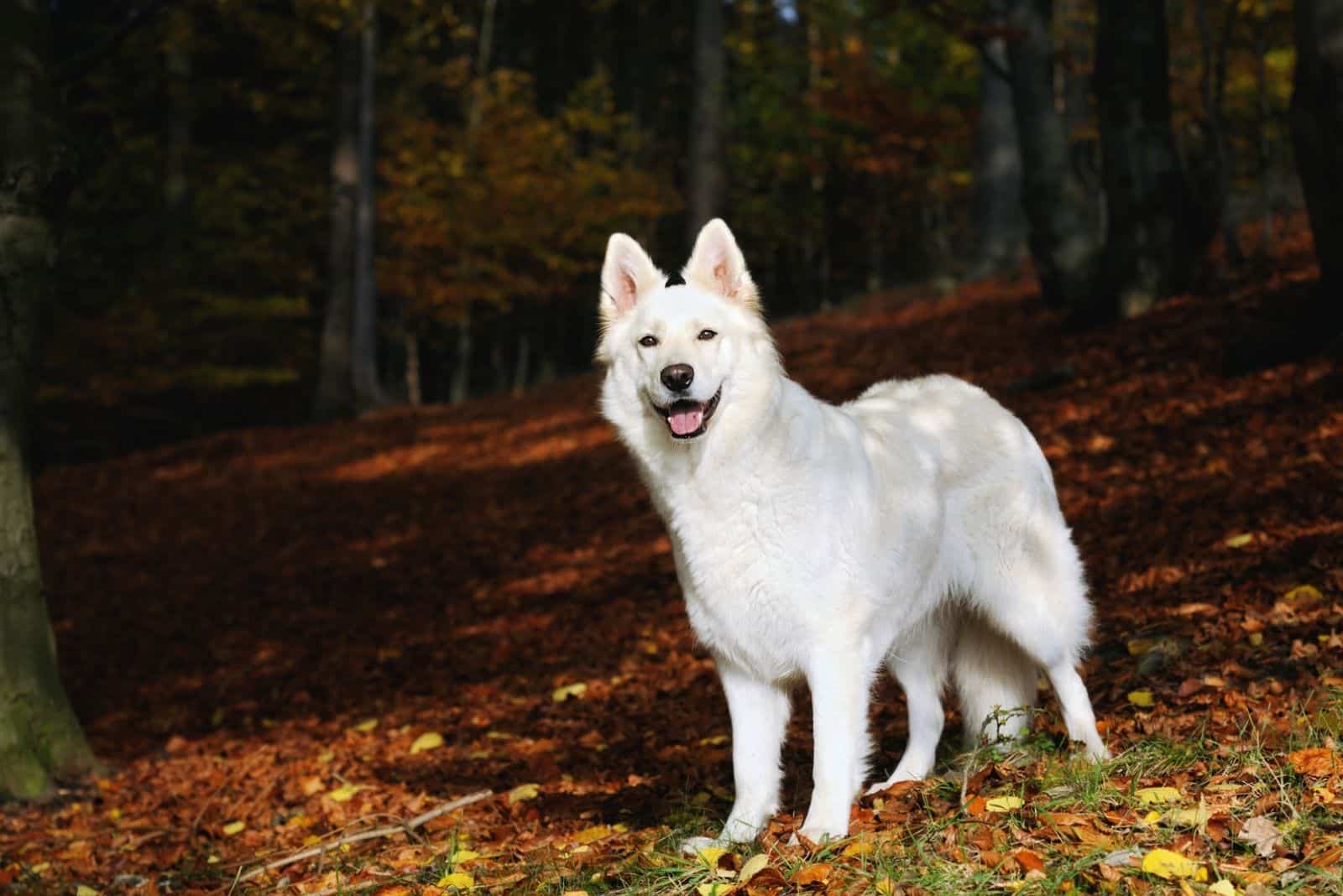
Dog coat color genetics is a fascinating subject:
No matter what color your dog is, the shades and tones are produced by two pigments: eumelanin and pheomelanin. Genetic markers are passed onto a pup from the parents that tell the cells in each hair follicle what colors to produce and how much.
Eumelanin is responsible for black, which can be diluted to make many other shades, from brown, to blue and gray. Pheomelanin produces red, and when diluted, it makes all shades of gold, yellow, or fawn.
Recessive Genes
Sometimes, a recessive white gene affects the coat, telling the cells not to produce any color whatsoever. A recessive gene has to be inherited from both parents if it’s to have any effect on the pup. Dominant genes usually mask these, which is why some colors are less common.
Despite what others may believe, white German Shepherds have been around since the beginning of the breed, when Captain Max von Stephanitz established it after buying his dog, Horand von Grafrath.
Stephanitz once famously said that the dog’s color made no difference, a fact that is conveniently forgotten today!
It’s interesting to note that the solid black German Shepherd has a true color, meaning that it is caused by a recessive gene that allows only black fur. The white coat is caused by a recessive masking gene, meaning that the pup’s true color is hidden by the white.
The White German Shepherd: A Separate Breed?
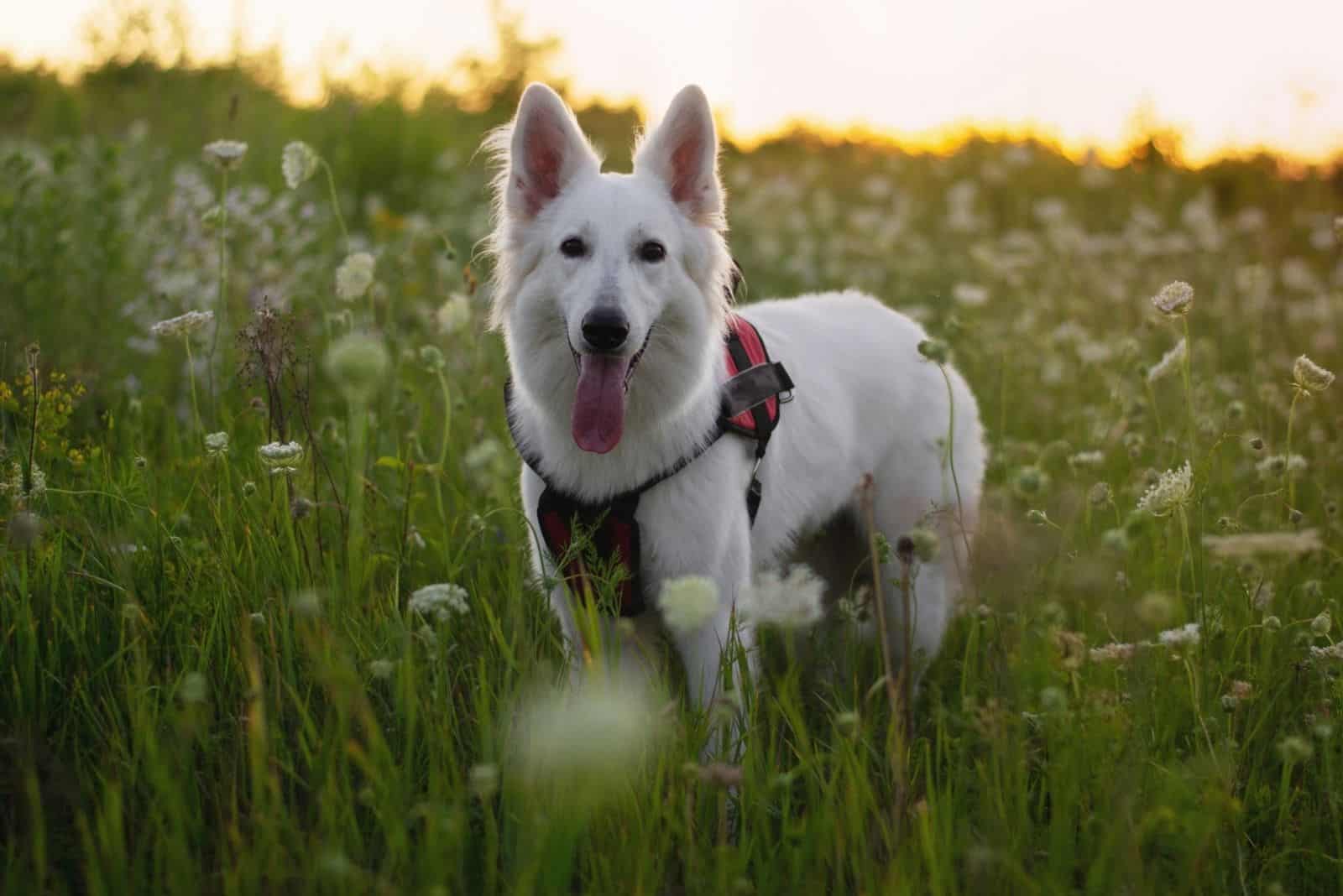
Attempts to rid the world of this amazing dog have been taken to extremes: some breeders still destroy white GSD pups at birth to ‘keep the bloodline pure.’ Registration of white dogs was banned, so it became impossible to find official records.
This kind of despicable behavior led enthusiasts to club together to protect white dogs. And so, the American White Shepherd Association and the White Shepherd Club of Canada were formed. Eventually, in 1999, the United Kennel Club (UKC) recognized these persecuted dogs as a separate breed.
Even so, the AKC still refuses to accept them and even extends this policy to the White Swiss Shepherd.
So, the White German Shepherd is now considered a breed in its own right, which will ensure its survival well into the future.
White German Shepherd Puppies

If you buy from a breeder, you’ll pick up your pup when it’s between 8 and 12 weeks of age. Anyone who releases their pups earlier than this should be avoided, as they are not ready to leave their mother before this time.
It’s better to have everything in place before you bring your pup home, as this will make things easier for you and allow the puppy time to settle in more quickly.
Sleepless Nights
The first three days may well be a challenge: your pup will miss its mother and siblings. It will feel lonely and confused, especially at night, so be prepared for broken sleep!
You may be woken if the pup needs a bathroom break, but mostly as it is missing its mom. This should lessen as time goes by and the bond between you and your dog gets stronger.
Training And Socialization
These are both critical elements in raising a well-adjusted adult dog. Just as nutritious dog food is vital to its physical health and development, all pups need guidance and training to help them learn how to behave appropriately.
A good-quality dog crate is ideal for dog training, and it provides a space where your puppy can feel safe and secure.
All the best breeders begin training and socializing their pups well before they leave the kennel, so be sure to try and find one that does this. Yes, you may pay extra, but it’s worth it!
These processes are essential and should begin the moment you get your pup through the door.
Teething
It’s as well to be prepared for this. There’ll be lots of whining, drooling, and chewing. It will make your pup feel pretty rough at times, so he’ll need extra fuss and cuddles. The good news is that they should be over it by the age of 7 or 8 months.
However, the whole process may last for 20 weeks or so. Your vet may prescribe medication if the symptoms are really bad. Otherwise, give your puppy chew toys or pieces of frozen banana or cold carrot.
Grooming
Many dogs don’t enjoy this! Brushing their coat or their teeth or clipping their nails can be a trial, to say the least. That’s why it’s best to establish a routine as early as possible. Dogs are happy with routine, and if you can get them used to the grooming procedure as a puppy, it will make your life much easier.
Grooming should include:
• Regular brushing (see the sections on coat types).
• Cleaning your dog’s teeth.
• Checking their ears weekly and wiping out any dirt and wax.
• Clipping their nails.
• Bathing when necessary.
Exercise
Pups don’t need anywhere near as much exercise as adult dogs, so don’t overdo it, or you risk damaging their joints!
The commonly accepted rule is that pups need five minutes of exercise for each month of their age. This refers to exercise on the leash, like a walk around the park to explore the sights, sounds, and smells.
So, a 6-month-old pup can enjoy a 30-minute walk.
Of course, they will enjoy the rough and tumble of playtime on top of this; just take care not to let them do too much in one day.
White German Shepherd Temperament
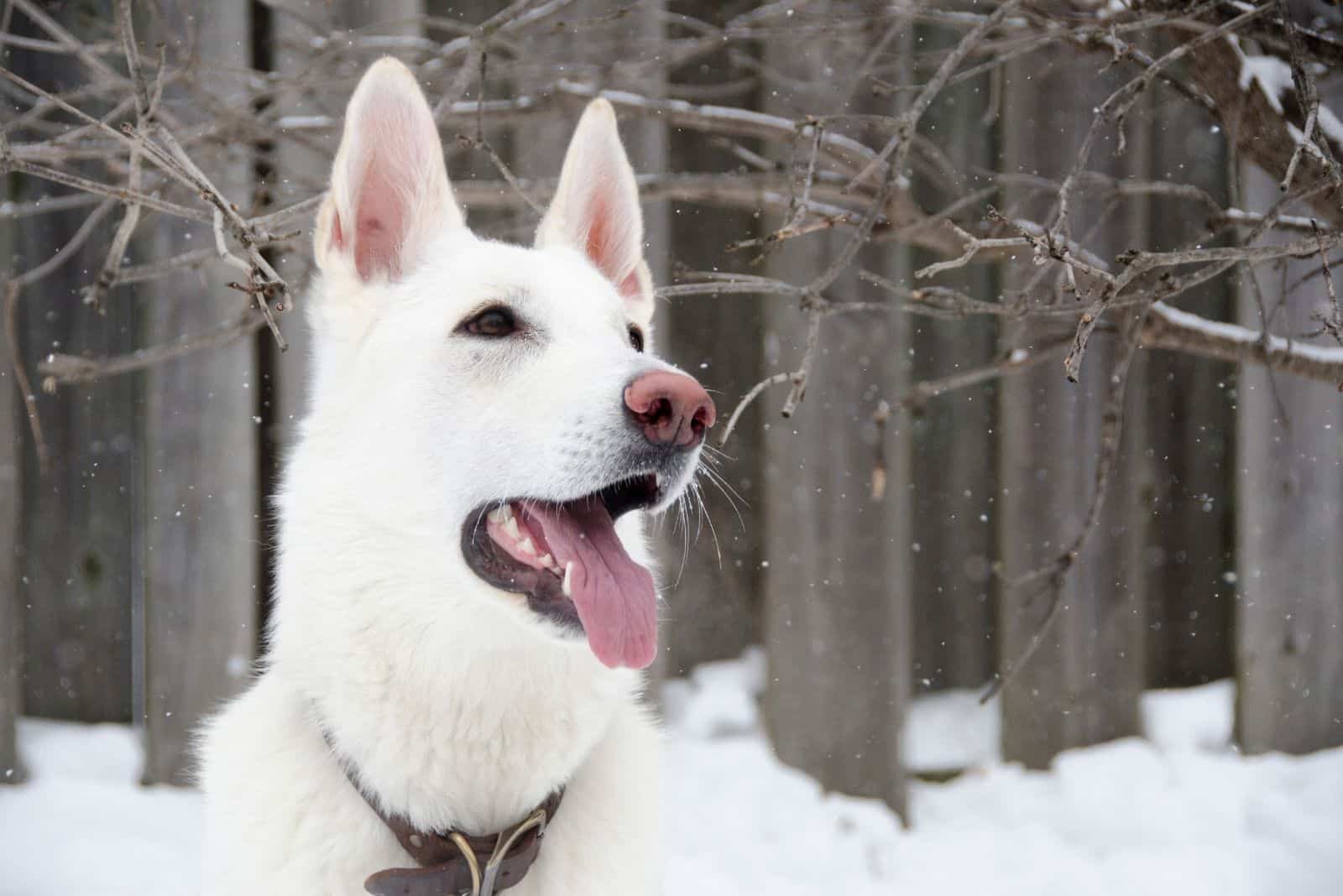
Although we touched on this earlier, let’s deal with this in more detail.
In some ways, being rejected as ‘undesirable’ has been good for this dog. Being regarded as a separate breed, and without the strict (and harmful) standards set by the AKC, breeders have been able to produce a healthier dog with a mellow temperament.
These dogs are ideal family pets, excellent with kids, and generally good with other dogs and animals in the household. Some may need careful socialization and training if kept with dogs of the same sex, but overall you shouldn’t have too many issues.
How Much Exercise?
Like the standard GSD, this high-energy dog needs at least ninety minutes of daily exercise. It’s best to split this into several short segments, with a couple of walks and several play sessions.
Mental stimulation for your dog is equally as important as physical exercise, or your furry friend will quickly become bored, and that’s when they start to act up!
When intelligent dogs get bored, they will make their own fun, so you can say goodbye to your plants and flowers, ornaments, sofa cushions, or whatever else your frustrated pooch decides to turn its attention to. They may also bark excessively, which isn’t great for fostering a good relationship with the neighbors.
Training Your White GSD
This should be a breeze, as these dogs are intelligent and eager to please you. Start training your dog as soon as possible to get the best results. Dog training classes are an excellent idea as they allow your furry pal to meet other dogs, which helps the socialization process.
Smart dogs love to be given a job to do, and few things make them happier. They enjoy learning and performing tricks, so be sure to teach them a few. They especially love being rewarded for a job well done, so be sure to give them treats and a lot of petting.
As with all German Shepherds, they may be wary and suspicious of strangers at first. Socialization helps overcome this issue, and you can make things easier by introducing strangers gradually and calmly, allowing the dog to accept them at their own pace.
All in all, White German Shepherds are excellent family dogs but perhaps aren’t an ideal choice for first-time dog owners.
White German Shepherd With Blue Eyes
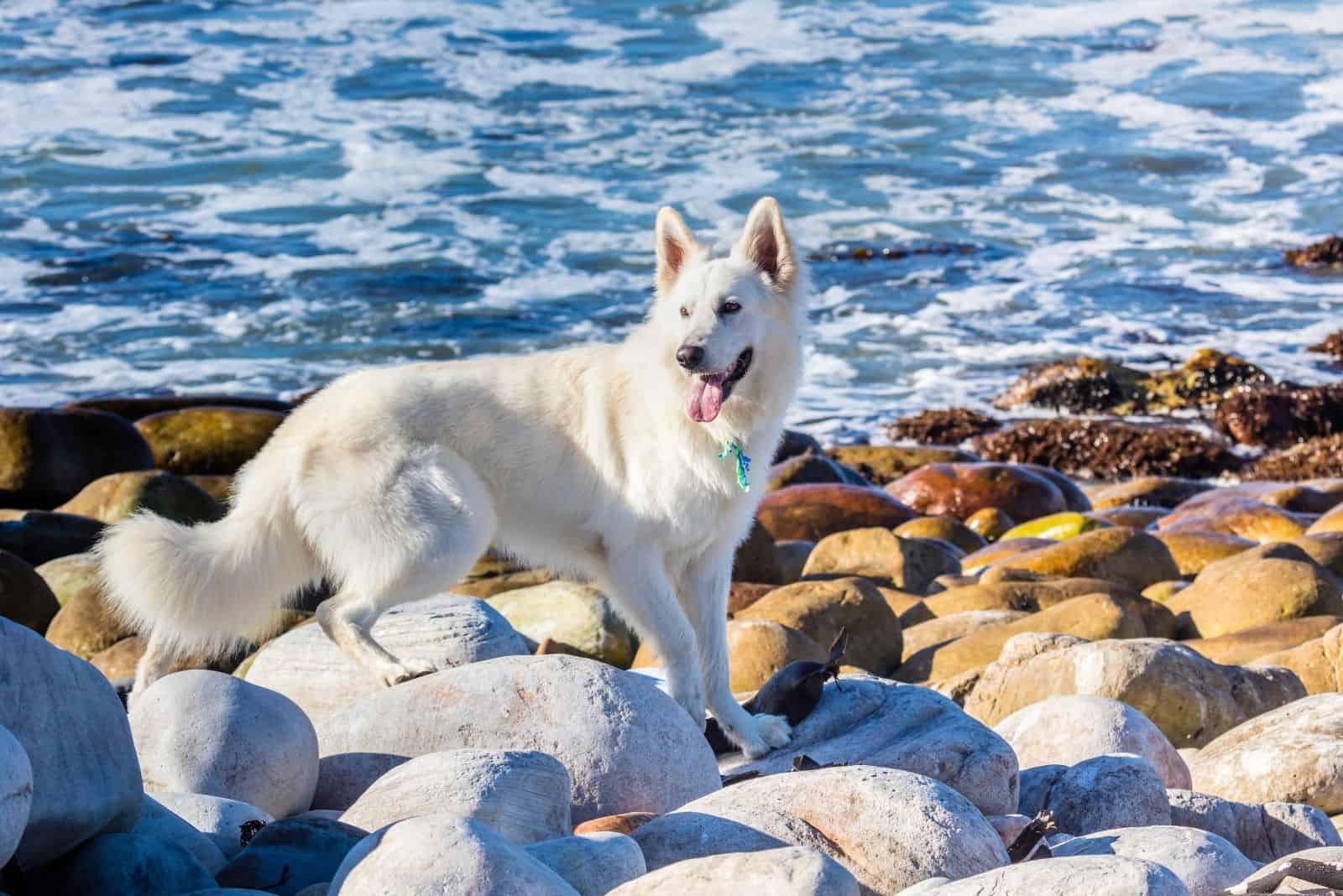
Most of these beauties have brown eyes, although occasionally, you’ll find some with stunning blue eyes!
You also get blue-eyed standard German Shepherds, but these are considered faulty too, and they are disqualified from AKC shows. As such, breeders tend to avoid breeding them deliberately. Learn more on this topic in our article on German Shepherds eye color.
The good thing about this is that the white dog is already disqualified, so it really doesn’t matter what color their eyes are!
Eye Color And Health Problems
Eye color is a touchy subject, as people claim that the gene that causes blue eyes is responsible for deafness. However, as already pointed out, this is nothing to do with the merle or piebald gene.
Some dogs have odd-colored eyes (one blue and one brown), sometimes referred to as heterochromia. It probably won’t be a total surprise to learn that the AKC doesn’t much like this either.
The blue eye color (or odd eye color) is caused by another recessive gene, and there is not a single shred of convincing evidence to support claims that blue-eyed White German Shepherds are at risk of blindness or deafness.
However, you should watch out for unscrupulous breeders cashing in on blue-eyed dogs.
Do White German Shepherds Have Health Problems?

Much like any other German Shepherd, the white version has a few common health issues to overcome:
• Hip dysplasia affects many purebred dog breeds, particularly large breeds. This condition is caused by a badly-formed hip joint where the bones grate against each other. Reputable breeders test for this condition in their parent dogs to reduce the risk, but it is a side effect of selective line breeding and almost impossible to eradicate.
• Elbow dysplasia is similar to the above condition but found in the elbow. It can be more problematic as the elbow is a complex joint. Surgery is frequently required to fix the problem, which is expensive and can be risky for the animal involved.
• Canine Epilepsy is distressing to witness and traumatic for the dog. Seizures can be mild or severe, although the condition can be managed using medication.
• Bloat is also known as gastric dilatation-volvulus or gastric torsion. This is one to be aware of, as it is potentially fatal! In most cases, the dog’s stomach inflates with gas or liquid, which becomes trapped inside. Sometimes, the stomach twists around, cutting off the blood flow to vital organs. Soft tissue that is starved of oxygen starts to die, and the pancreas begins to produce toxins that can stop the dog’s heart.
• Degenerative myelopathy is a disease that leads to lameness and paralysis as it affects the dog’s spinal cord. Older dogs are usually affected (between 8 and 10), and there is no cure. Treatment aims to make the dog comfortable for the remainder of its life, which is usually 2 to 3 years after diagnosis.
• Cancer, more specifically, hemangiosarcoma, affects German Shepherds more than other breeds. This aggressive and malignant cancer attacks the circulatory system, often without presenting any symptoms until it’s too late.
Although this list is daunting, there’s a good chance that your own furry companion will avoid them. You can help by getting your dog from an ethical and reputable breeder, as they will test their dogs for common health problems.
As for bloat, it’s best to avoid letting your dog eat or drink too much too quickly, especially just before or just after vigorous exercise.
White German Shepherd: Lifespan
This is an interesting topic, as the GSD’s lifespan differs depending on who you ask!
For example, the American Kennel Club (AKC) puts it at 7 to 10 years. However, many other people claim that it is between 9 and 13, or 10 and 14 years.
So, why the difference?
Sadly, much of this depends on your location or which breeder you use. If you live in Europe or buy from a breeder that imports German or European dogs, your pooch will likely live longer.
In recent years, AKC breed standards were altered to stipulate that these dogs should have a steeper slope to their back. This puts the joints and the spine under a lot of extra strain, often resulting in dogs being euthanized at an early age as the joints become damaged.
As white German Shepherds fall outside the breed standards, they are not subject to this harmful rule.
As a result, the white GSD enjoys an average lifespan of between 12 and 14 years!
White German Shepherd: Short Hair
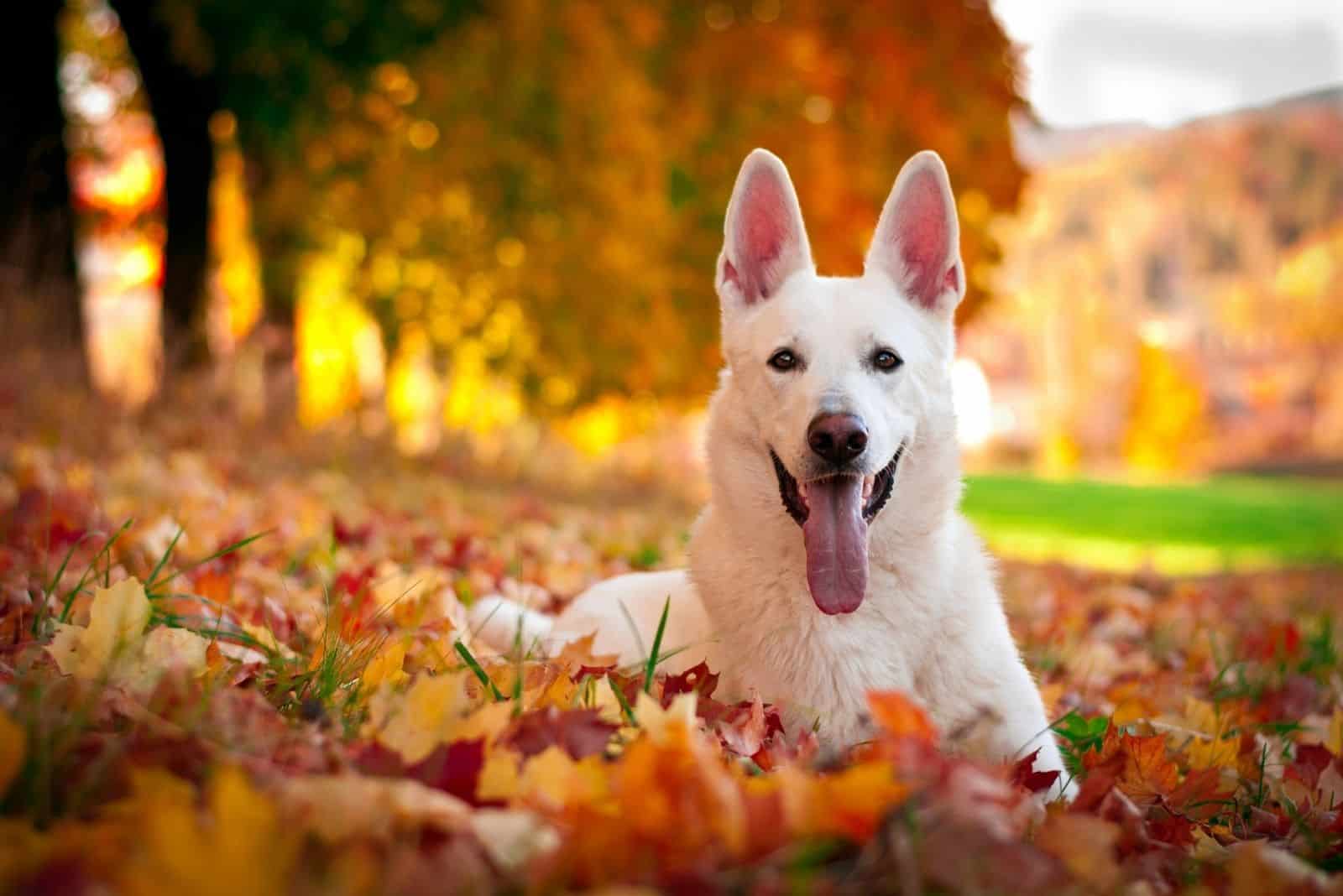
These fantastic dogs come in two types: long hair and short hair.
The short-haired variety is more common than those with long hair, although both have the same double coat (although there is a single-coated version – see below) with a white fur undercoat.
As you’d expect, the short coat is easier to maintain, although they shed heavily all year round and blow their undercoat twice a year.
Unless you stick to a regular grooming routine, this white fur will get everywhere! You might consider investing in a special vacuum cleaner that can handle pet hair, too. White hair is a nightmare, as it shows up on everything unless all your furniture and decor is white.
It’s called short hair, but in reality, it’s medium-length. The outer hairs are dense, straight, and coarse to the touch but easy to brush.
White German Shepherd: Long Hair
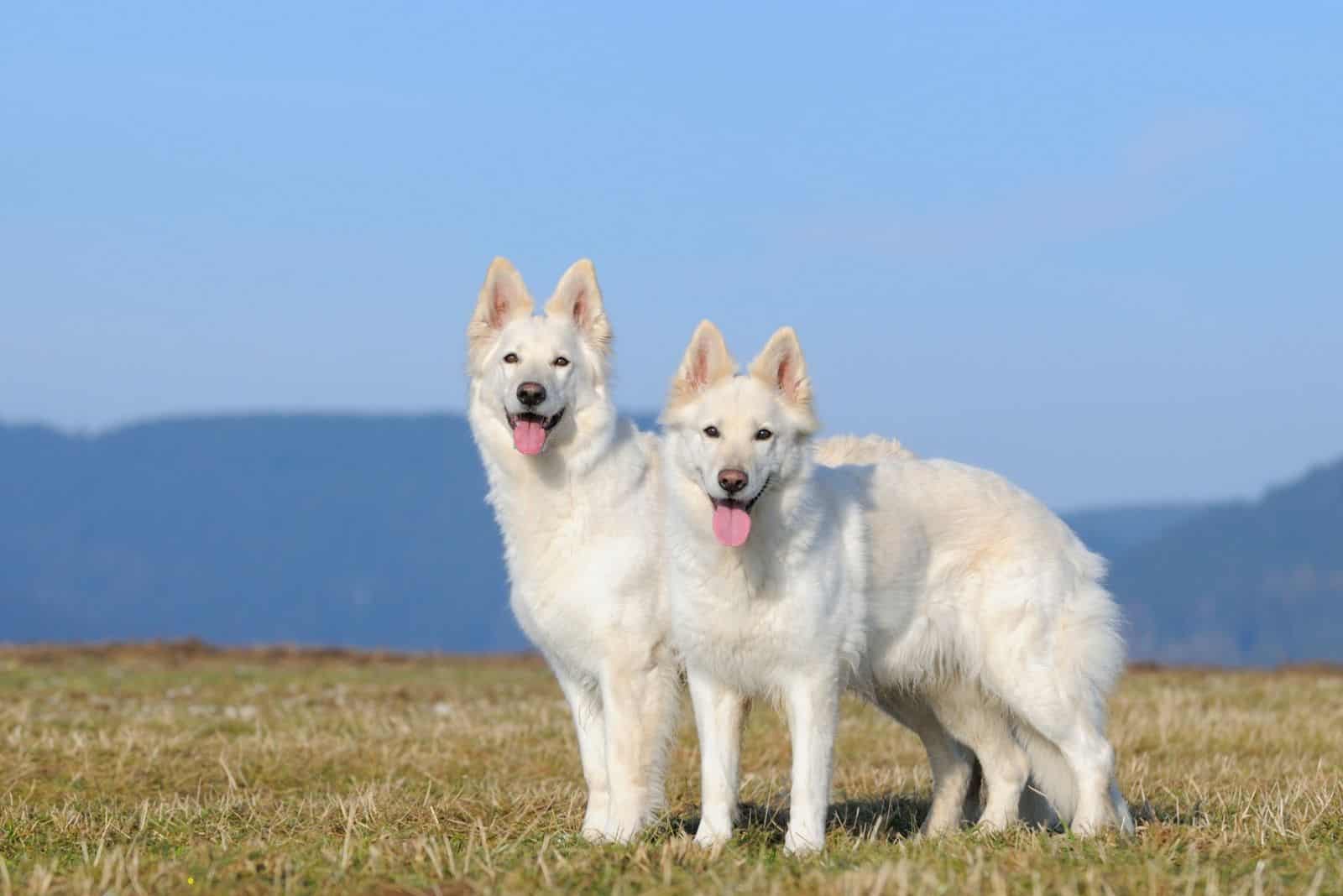
Most long-haired white GSDs have a double coat, too. These need regular brushing to control how much fur winds up on your furniture and avoid tangles and matting.
Matted or tangled fur can cause your pooch a lot of pain and discomfort as it tugs on the skin when the hair catches on obstacles or when the dog moves.
Dirt and debris get trapped in the coat, which can lead to skin infections.
Of the two, long-haired White German Shepherds seem to shed less, but this is only because the dead hairs become trapped in the coat.
As mentioned above, both have a double coat, although another recessive gene can cause these beautiful dogs to have a single coat! That means they don’t have a furry undercoat, so there’ll be a lot less shedding.
The AKC regards this as a ‘minor fault’ in standard GSDs, but that’s irrelevant to these beautiful white dogs.
White German Shepherd Price
You should expect to pay between $1,000 and $1,500 for your white puppy.
This is a pretty good price, considering that you might pay between $1,500 and $3,500 for any other acceptable color!
No good breeder will ever charge more for a ‘rare’ color, so you should be very wary of anyone charging massively over the odds. Even so, you can’t blame a breeder for adding a few dollars to the price if they have a unique pup: it’s just how business works!
If, on the other hand, the puppy is priced too low, you should be cautious about buying. Breeding puppies properly is a costly business, and few breeders make much (or any!) profit.
We all love a bargain, but if you buy cheap puppies, you may pay for it later in vet bills.
White German Shepherd Breeders

White German Shepherd pups turn up in litters all the time. They are still purebred dogs, despite claims to the contrary by some people. They are not faulty or deficient in any way; they are simply German Shepherds that happen to be white.
Reputable, ethical breeders will still sell you a white puppy, but they will always make you aware of the limitations in relation to entering AKC conformation shows. They may also make you sign a spay/neuter agreement to stop your pup from potentially passing on its white coat.
This isn’t unexpected, as most breeders include these agreements to protect the bloodlines they’ve invested in.
Only Use Reputable Breeders!
If you want one of these beautiful white pups, your best bet is to find a reputable White German Shepherd breeder. They’ll charge a fair price, considering all the care, effort, money, and time it takes to produce a healthy litter of pups.
A breeder specializing in white dogs has a better understanding of them and a passion for these amazing canines. You won’t find any negativity or unfounded tales about them being unhealthy or defective here!
To get you started, check out the American White Shepherd Association and the White Shepherd Club of Canada, as their websites have contact details of some of the best breeders.
White German Shepherds For Adoption
Instead of buying from a dog breeder, why not adopt? Adopting a dog is always the best option, and that’s a fact.
Ask any good breeder, and they’ll tell you the same, even if they lose out on a sale.
Far too many dogs languish in shelters and rescues every year: approximately three million at any one time!
It’s always worth checking out your local shelters and rescues to see if they have what you’re looking for. However, as these dogs aren’t as commonly seen as many other breeds, you may have to wait a while.
Adopting isn’t only cheaper than buying from a breeder (average fees are between $200 and $500), but you’ll get a dog that’s been housetrained, assessed for medical problems and behavioral issues, and is past the puppy stage.
The chances are that your new pooch will have received basic training, at the very least. Each dog is different, and a rescue dog may have been through a traumatic experience, but it’s safe to say that you’ll have a furry pal with a lot of love to give.
Avoid Puppy Mills!
There are at least 10,000 of these in the US, some of which are licensed by the local authorities. Does this make them good places to buy your dog?
Unfortunately not.
Puppy mills are set up for profit alone, usually at the expense of the dogs’ welfare. These animals are kept in cramped, unsanitary conditions and fed low-quality food to cut costs. Their pups are usually sickly, weak, and suffer from genetic health issues.
The parent dogs are isolated in cages, except when forced to breed. Females are bred whenever possible, often to the point of exhaustion and with little recovery time. And when these poor dogs are no longer useful, they are disposed of.
Pet stores and online markets are two outlets for puppy mills, so you need to be very careful where you buy your dog.
As a general rule, it’s best to avoid them altogether!
Are White German Shepherds Rare?
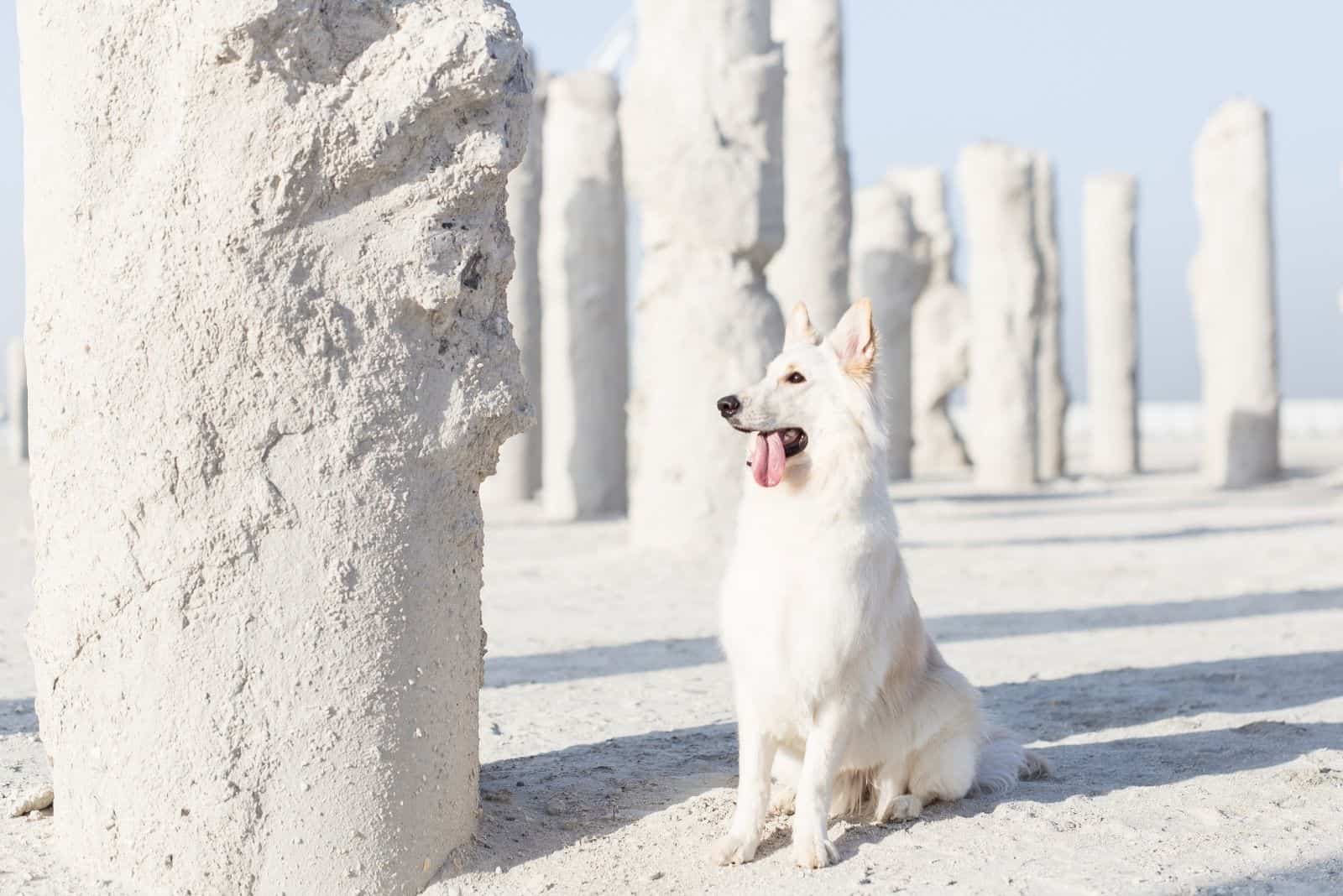
Not as rare as they once were! Still, they are not as commonly seen as other colors, particularly black and tan.
Considering that the GSD is number two on the AKC list of the 204 most popular breeds, you might think there’d be far more white GSDs around.
As we’ve seen, these wonderful dogs have had a hard time over the years, and opposition to them is still strong.
However, their popularity is growing, primarily because dog lovers have come to know how brilliant they are. Also, some of the unfounded myths are starting to be exposed for what they are, and people are learning the truth.
The Albino Link
When you Google White German Shepherds, especially about how rare they are, you’ll find that many of the results talk about albino dogs. This only causes more confusion by keeping alive the false belief that White German Shepherds are albino!
As we stated earlier, they are not albino.
Albino dogs are extremely rare: you are unlikely to ever meet one in real life.
Is The White GSD The Dog For You?
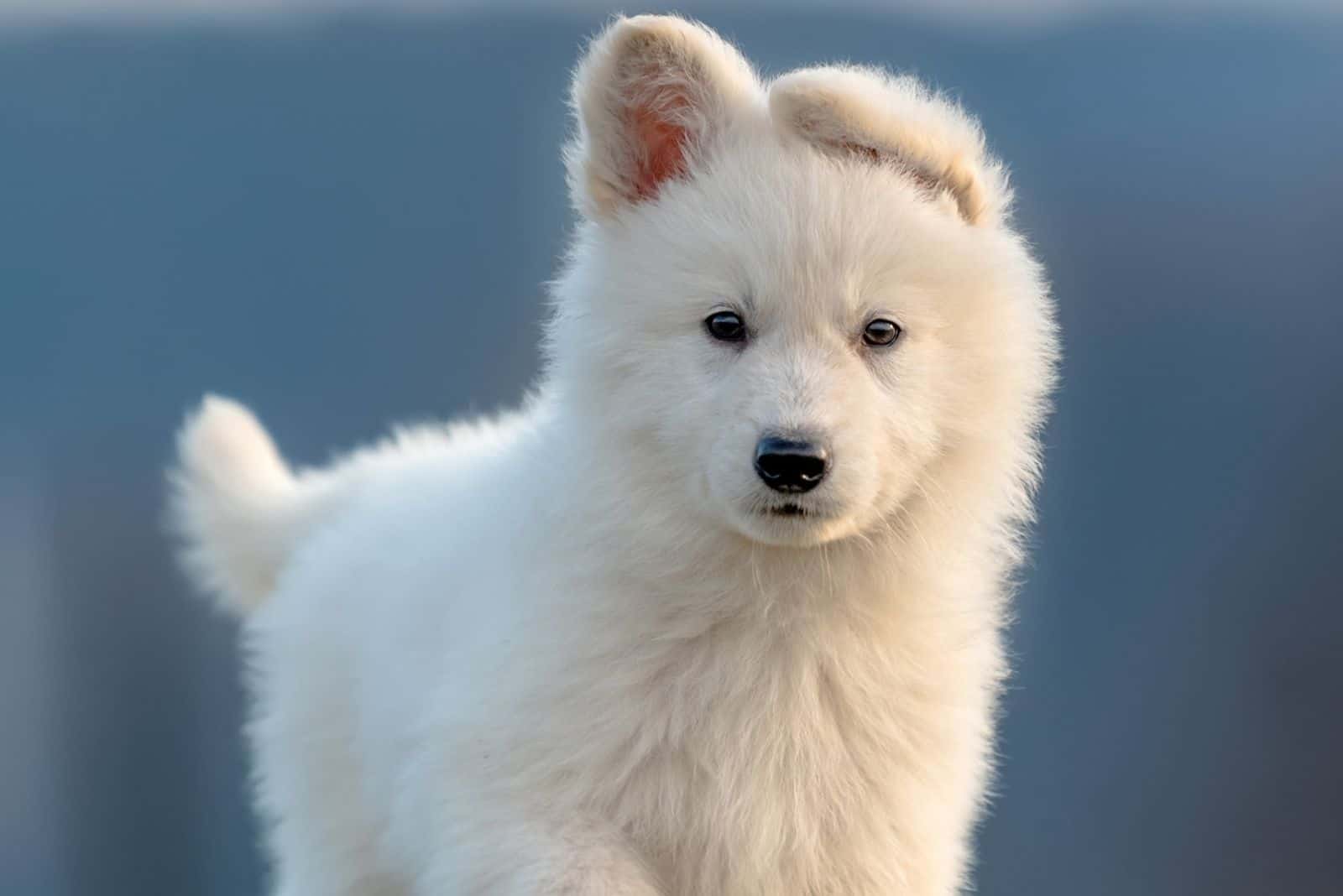
Now you’ve learned almost everything there is to know about the White German Shepherd!
In appearance, they resemble the standard dog in many ways, though it’s likely that they won’t have such a steeply sloped back. This is a good thing because your pooch won’t suffer the same joint problems as the standard dog.
Many standard German Shepherd breeders shun the restrictive and damaging AKC breed standards in favor of the European and German versions because of this.
Your White GSD will have a lifespan of between 12 and 14 years. Get it from a good breeder, and you’ll increase your chances of keeping your dog around for longer.
Give them a healthy diet, plenty of exercise, a lot of love, and regular check-ups at the vet, and you’ll boost those chances even more.
This canine companion is loving and affectionate with all family members, and it adores kids in particular. It’s naturally wary or timid around strangers, though you can usually resolve this by socializing your pup at an early age.
Although it isn’t technically a different breed, circumstances forced people to take steps to protect and preserve them, and so they became a breed in their own right.
Finally, if you’ve fallen in love with one of these fantastic white dogs, you can play your part in preserving the breed for the future by getting one of your own. Maybe you can be an ambassador for the White GSD and spread the truth about this wonderful breed!